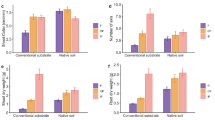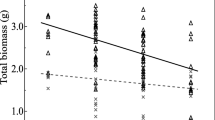Abstract
In nature conditions, mutualization of ericaceous plant (Ericaceae) roots with mycorrhizal fungi or other soil symbiotic fungi improves efficiency on nutrient uptake and tolerance to heavy metal stress. Effects of ericoid mycorrhizal fungi (EMF) or dark septate endophyte (DSE) colonization have been evaluated in highbush blueberry (Vaccinium corymbosum) but remained unclear in rabbiteye blueberry (V. virgatum Ait.). In this study, callused cuttings of ‘NTU-104’ rabbiteye blueberry were grown in substrate containing either sterilized (SP) or unsterilized (UP) nature Finnish peat moss as a fungal inoculum. Vegetative growth, fungal colonization frequency (Cf) and intensity (Ci), substrate pH and electrical conductivity (EC), and plant nutritional elements were assessed. Sterilization did not completely exclude fungi resources in the peat moss and colonization of EMF and DSE was found in both SP and UP substrate types. Regardless, UP treatment resulted in greater total Cf (69.3%) and Ci (9.91%) than those of SP (41.49% and 6.17%, respectively). In either substrate type, both Cf and Ci of DSE were greater than those of EMF. Plants in UP treatment produced more shoots (2.33), number of leaves (76.33), greater total leaf area (494.18 cm2), and shoot length (121.78 cm) than in SP substrate (1.67, 24.17, 116.13 cm2, and 30.22 cm, respectively). Fresh weights of roots, shoots, and leaves in UP plants were significantly greater (7.57, 9.64, and 15.25 g, respectively) than in SP plants (1.29, 2.62, and 3.08 g, respectively). Dry weights of roots, shoots, and leaves in UP plants were also significantly greater (4.34, 2.37, and 4.51 g, respectively) than in SP plants (0.67, 0.47, and 0.90 g, respectively). Concentrations of phosphorous and magnesium in roots and potassium in shoots were increased in UP plants while other nutritional elements remained consistent. Contents of all nutritional elements were increased in UP plants due to greater dry weight. After the establishment of the transplants, pH and EC of both substrate types were in the optimal range for blueberries but significant lower pH while higher EC were measured in UP substrate. The results indicated that using nature Finnish peat moss as a symbiotic fungi inoculum was capable of establishing symbiotic fungal colonization and promoting rooting and vegetative growth in rabbiteye blueberry cuttings.




Similar content being viewed by others
References
Berns AE, Philipp H, Narres H-D, Burauel P, Vereecken H, Tappe W (2008) Effect of gamma-sterilization and autoclaving on soil organic matter structure as studies by solid state NMR, UV and fluorescence spectroscopy. Eur J Soil Sci 59:540–550
Biermann B, Linderman RG (1981) Quantifying vesicular-arbuscular mycorrhizae: a proposed method towards standardization. New Phytol 87:63–67
Bizabani C, Fontenla S, Dames JF (2016) Ericoid fungal inoculation of blueberry under commercial production in South Africa. Sci Hortic 209:173–177
Bradley R, Burt AJ, Read DJ (1982) The biology of mycorrhiza in the Ericaceae. VIII. The role of mycorrhizal infection in heavy metal resistance. New Phytol 91:197–209
Buessecker S, Tylor K, Nye J, Holbert KE, Urquiza Muñoz JD, Glass JB, Hartnett HE, Cadillo-Quiroz H (2019) Effects of sterilization techniques on chemodenitrification and N2O production in tropical peat soil microcosms. Biogeosciences 16:4601–4612
Carter DO, Yellowees D, Tibbett M (2007) Autoclaving kills soil microbes yet soil enzymes remain active. Pedobiologia 51:295–299
Currah RS, Niemi M, Huhtinen S (1999) Oidiodendron maius and Scytalidium vaccinii from the mycorrhizas of Ericaceae in northern Finland. Karstenia 39:65–68
Gadd GM (1999) Fungal production of citric and oxalic acid: importance in metal speciation, physiology and biogeochemical processes. Adv Microb Physiol 41:47–92
Grünig CR, Queloz V, Sieber TN, Holdenriedera O (2008) Dark septate endophytes (DSE) of the Phialocephala fortinii s.l.–Acephala applanata species complex in tree roots: classification, population biology, and ecology. Botany 86:1355–1369
Haselwandter K, Dobernigg B (1992) Isolation and identification of hydroxamate siderophores of ericoid mycorrhizal fungi. BioMetals 5:51–56
Hashem AR (1995) The role of mycorrhizal infection in the resistance of Vaccinium macrocarpon to manganese. Mycorrhiza 5:289–291
Jumpponen A, Trappe JM (1998) Dark septate endophytes: a review of facultative biotrophic root-colonizing fungi. New Phytol 140:295–310
Koron D, Gogala N (2000) The use of mycorrhizal fungi in the growing of blueberry plants (Vaccinium corymbosum L.). Acta Hortic 525:101–105
Leak JR, Read DJ (1990) Chitin as a nitrogen source for mycorrhizal fungi. Mycol Res 94:993–995
Li, Y-C (2020) Peat moss as an inoculum of symbiotic fungi promoted the growth in rabbiteye blueberry (Vaccinium virgatum Aiton) cuttings. Master thesis, National Taiwan University, Taipei, Taiwan
Mandyam K, Jumpponen A (2005) Seeking the elusive function of the root-colonising dark septate endophytic fungi. Stud Mycol 53:173–189
Newsham KK (2011) A meta-analysis of plant responses to dark septate root endophytes. New Phytol 190:783–793
Powell CL, Bagyaraj DJ (1984) Effect of mycorrhizal inoculation on the nursery production of blueberry cuttings—a note. N Z J Agric Res 27:467–471
Powell CL, Bates PM (1981) Ericoid mycorrhizas stimulate fruit yield of blueberry. Hortic Sci 16:655–656
Retamales JB, Hancock JF (2012) Blueberries. CAB Intl, Oxfordshire
Ruotsalainen AL (2018) Dark septate endophytes (DSE) in boreal and subarctic forests. In: Pirttilä AM, Frank AC (eds) Endophytes of forest trees. Springer, Heidelberg, pp 105–117
Sadowsky JJ, Hanson EJ, Schilder AMC (2012) Root colonization by ericoid mycorrhizae and dark septate endophytes in organic and conventional blueberry fields in Michigan. Int J Fruit Sci 12:169–187
Scagel CF (2005) Inoculation with ericoid mycorrhizal fungi alters fertilizer use of highbush blueberry cultivars. Hortic Sci 40:786–794
Scagel CF, Wagner A, Winiarski P (2005) Inoculation with ericoid mycorrhizal fungi alters root colonization and growth in nursery production of blueberry plants from tissue culture and cuttings. Small Fruit Rev 4:113–135
Selosse M, Setaro S, Glatard F, Richard F, Urcelay C, Weiss M (2007) Sebacinales are common mycorrhizal associates of Ericaceae. New Phytol 174:864–878
Sietio OM, Tuomivirta T, Santalahti M, Kiheri H, Timonen S, Sun H, Fritze H, Heinonsalo J (2018) Ericoid plant species and Pinus sylvestris shape fungal communities in their roots and surrounding soil. New Phytol 218:738–751
Smith SE, Read DJ (2008) Mycorrhizal symbiosis, 3rd edn. Academic Press, Boston, MA
Stafne ET, Matta FB, Barickman TC (2017) Effects of inoculation with ericoid mycorrhizal fungi on leaf nutrients of two field-grown rabbiteye blueberry cultivars. Acta Hortic 1180:117–122
Strandberg M, Johansson M (1999) Uptake of nutrients in Calluna vulgaris seed plants grown with and without mycorrhiza. For Ecol Manag 114:129–135
Stuart NW (1936) Adaptation of the micro-Kjeldahl method for the determination of nitrogen in plant tissues. Plant Physiol 11:173–179
Tanaka S, Kobayashi T, Iwasaki K, Yamane S (2003) Properties and metabolic diversity of microbial communities in soils treated with steam sterilization compared with methyl bromide and chloropicrin fumigations. Soil Sci Plant Nutr 49:603–610
Tejesvi M, Ruotsalainen A, Markkola A, Pirttilä AM (2010) Root endophytes along a primary succession gradient in northern Finland. Fungal Divers 41:125–134
Thormann MN (2006) The role of fungi in boreal peatlands. In: Wiederand RK, Vitt DH (eds) Boreal peatland ecosystems. Springer, Berlin, pp 101–123
Thormann MN, Rice AV (2007) Fungi from peatlands. Fungal Divers 24:241–299
Usuki F, Narisawa K (2007) A mutualistic symbiosis between a dark septate endophytic fungus, Heteroconium chaetospira, and a nonmycorrhizal plant, Chinese cabbage. Mycologia 99:175–184
Vohník M, Albrechtová J (2011) The co-occurrence and morphological continuum between ericoid mycorrhiza and dark septate endophytes in roots of six European rhododendron species. Folia Geobot 46:378–386
Vohník M, Albrechtová J, Vosátka M (2005) The inoculation with Oidiodendron maius and Phialocephala fortinii alters phosphorus and nitrogen uptake, foliar C:N ratio and root biomass distribution in Rhododendron cv. Azurro. Symbiosis 40:87–96
Wu J, Lin X (2003) Effects of soil microbes on plant growth. Soil 35:18–21
Yang H, Zhao X, Liu C, Bai L, Zhao M, Li L (2018) Diversity and characteristics of colonization of root-associated fungi of Vaccinium uliginosum. Sci Rep 8:1–14
Acknowledgements
We thank Prof. H.-L. Lin for assistance on element analysis, Prof. C.-L. Lee for supervising, and Prof. J.-C. Chang for reviewing the original results. This project was partially supported by Ministry of Science and Technology Taiwan (project code: MOST-107-2313-B-002-029-MY) and Taiwan Flower & Biotechnology Co., Ltd., Taiwan.
Author information
Authors and Affiliations
Contributions
Yu-Chuan Li contributed to data curation, investigation, formal analysis, visualization and writing original draft. Shiang-Jiuun Chen contributed to methodology, result visualization and interpretation, and draft reviewing. Kuo-Tan Li contributed to conceptualization, methodology, project administration, fund acquisition, supervision, draft reviewing, revising and editing.
Corresponding author
Ethics declarations
Conflict of interest
The authors have no known competing financial interests or personal relationships that could have appeared to influence the work reported in this paper.
Additional information
Communicated by Yong-Bum Kwack, Ph.D.
Publisher's Note
Springer Nature remains neutral with regard to jurisdictional claims in published maps and institutional affiliations.
Rights and permissions
About this article
Cite this article
Li, YC., Chen, SJ. & Li, KT. Symbiotic fungi in nature Finnish peat moss promote vegetative growth in rabbiteye blueberry cuttings. Hortic. Environ. Biotechnol. 62, 191–198 (2021). https://doi.org/10.1007/s13580-020-00313-y
Received:
Revised:
Accepted:
Published:
Issue Date:
DOI: https://doi.org/10.1007/s13580-020-00313-y




